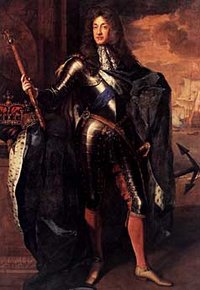James II of England
James II of England and VII of Scotland (14 October 1633–16 September 1701) became King of England, King of Scots, and King of Ireland on 6 February 1685. He was the last Roman Catholic monarch to reign over the Kingdom of England, Kingdom of Scotland, and Kingdom of Ireland. Some of his subjects distrusted his religious policies and alleged despotism, leading a group of them to depose him in the Glorious Revolution. He was replaced not by his Roman Catholic son, James Francis Edward, but by his Protestant daughter and son-in-law, Mary II and William III, who became joint rulers in 1689. The belief that James—not William III or Mary II—was the legitimate ruler became known as Jacobitism (from Jacobus or Iacobus, Latin for James). James did not himself attempt to return to the Throne, instead living the rest of his life under the protection of King Louis XIV of France. His son James Francis Edward Stuart and his grandson Charles Edward Stuart (Bonnie Prince Charlie) attempted to restore the Jacobite line after James's death, but failed.
Early life
James, the second surviving son of Charles I and Henrietta Maria of France, was born at St. James's Palace in 1633 and created Duke of York in 1644. During the English Civil War—in which his father fought English Parliamentary and Puritan forces—he stayed in Oxford, a Royalist stronghold. When the city surrendered in 1646, the Duke of York was confined in St James's Palace by parliamentary command. In 1648, he escaped from the Palace, whence he went to The Hague in disguise. When Charles I was executed by the rebels in 1649, monarchists proclaimed the Duke of York's elder brother, Charles, as King Charles II. Charles II was recognised by the Parliament of Scotland and the Parliament of Ireland, and was crowned King of Scots at Scone, in Scotland, in 1651. He was, however, unable to secure the Crown of England, and consequently fled to France.
Like his brother, the Duke of York sought refuge in France, serving in the French army under Turenne. In 1656, when his brother, Charles, entered into an alliance with Spain—an enemy of France—he joined the Spanish army under Louis, Prince of Condé. Both Turenne and Condé praised the Duke of York's abilities.
In 1660, with Oliver Cromwell dead, Charles II was restored to the English Throne, the Duke of York returning to England with him. Though he was the heir-presumptive, it seemed unlikely that the Duke of York would actually inherit the Crown, for Charles was still a young man capable of fathering children. In September 1660, the Duke of York (who was also created Duke of Albany in Scotland) married the Lady Anne Hyde, the daughter of Charles's chief minister, Edward Hyde, 1st Earl of Clarendon.
The Duke of York was appointed Lord High Admiral and commanded the Royal Navy during the Second (1665–1667) and Third Anglo-Dutch War (1672–1674). Following its capture by the English in 1664, the Dutch territory of New Netherland was named New York in his honour, as was the town of New Amsterdam. Fort Orange, 150 miles up the River Hudson, was renamed Albany in his honour as well. The Duke of York also headed the Royal African Company, which participated in the slave trade.
Religion
The Duke of York was admitted to the Roman Catholic Church in 1668 or 1669. His Protestant enemies in the Parliament of England, led by Anthony Ashley Cooper, 1st Earl of Shaftesbury, ensured the passage of the Test Act; under the Act, all civil and military officials were required to take an oath (in which they were required not only to disavow the doctrine of transubstantiation, but also denounce certain practices of the Roman Catholic Church as "superstitious and idolatrous") and receive communion under the auspices of the Church of England. The Duke of York refused to perform both actions, instead choosing to relinquish the post of Lord High Admiral.
Charles II opposed the conversion, ordering that the Duke of York's children be raised as Protestants. Nevertheless, in 1673, he allowed York (whose first wife had died in 1671) to marry the Catholic Mary of Modena. Some English people distrusted Catholicism and regarded the new Duchess of York as an agent of the Pope.
In 1677, the Duke of York attempted to appease Protestants by allowing his daughter, Mary, to marry the Protestant Prince of Orange, William III (who was also his nephew). Despite the concession, fears of a Catholic monarch persisted, intensified by the failed pregnancies of Charles II's wife, Catherine of Braganza. A defrocked Anglican clergyman, Titus Oates, falsely spoke of a "Popish Plot" to kill Charles and put the Duke of York on the Throne. The fabricated plot caused a wave of anti-Catholic hysteria to sweep across the nation. The Duke of York wisely decided to

